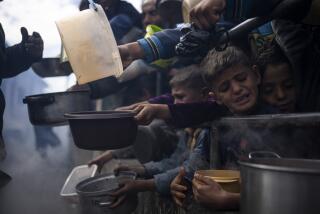Famine in Somalia
- Share via
The horrors being experienced by Somalis could have been prevented, at least somewhat, by early intervention last year. One organization, the International Fund for Agricultural Development, provides some hope that long-term solutions might still exist.
IFAD’s program in sub-Saharan Africa provided 300,000 Ethiopian families with 2,000 tons of seed and 1 million farm tools after the famine in 1983. This was desperately needed since the Ethiopians had eaten all the seed set aside for the next year’s planting in an attempt to avert starvation.
The secondary tragedy of famine is that because farmers are displaced (leaving their farms in search of feeding centers) and because seed is consumed, it assures that there will be no harvest in the following year--thus a second year of famine often follows the first.
The U.S. can play a role in preventing future families in the many African nations, including Somalia, which are currently threatened. The U.S. pledge is to give $10 million to IFAD’s Program for Sub-Saharan Africa. We should ensure that this promise is kept.
ANNA AMARANDOS
Huntington Beach
More to Read
Sign up for Essential California
The most important California stories and recommendations in your inbox every morning.
You may occasionally receive promotional content from the Los Angeles Times.













